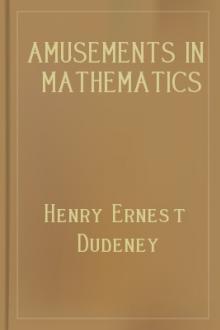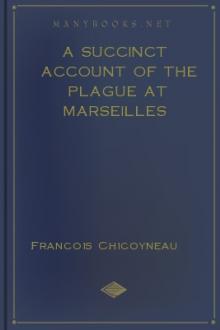Amusements in Mathematics, Henry Ernest Dudeney [books to read to be successful txt] 📗

- Author: Henry Ernest Dudeney
- Performer: 0486204731
Book online «Amusements in Mathematics, Henry Ernest Dudeney [books to read to be successful txt] 📗». Author Henry Ernest Dudeney

172.—MRS. SMILEY'S CHRISTMAS PRESENT.—solution

The first step is to find six different square numbers that sum to 196. For example, 1 + 4 + 25 + 36 + 49 + 81 = 196; 1 + 4 + 9 + 25 + 36 + 121 = 196; 1 + 9 + 16 + 25 + 64 + 81 = 196. The rest calls for individual judgment and ingenuity, and no definite rules can be given for procedure. The annexed diagrams will show solutions for the first two cases stated. Of course the three pieces marked A and those marked B will fit together and form a square in each case. The assembling of the parts may be slightly varied, and the reader may be interested in finding a solution for the third set of squares I have given.
173.—MRS. PERKINS'S QUILT.—solution
The following diagram shows how the quilt should be constructed.

There is, I believe, practically only one solution to this puzzle. The fewest separate squares must be eleven. The portions must be of the sizes given, the three largest pieces must be arranged as shown, and the remaining group of eight squares may be "reflected," but cannot be differently arranged.
174.—THE SQUARES OF BROCADE.—solution

So far as I have been able to discover, there is only one possible solution to fulfil the conditions. The pieces fit together as in Diagram 1, Diagrams 2 and 3 showing how the two original squares are to be cut. It will be seen that the pieces A and C have each twenty chequers, and are therefore of equal area. Diagram 4 (built up with the dissected square No. 5) solves the puzzle, except for the small condition contained in the words, "I cut the two squares in the manner desired." In this case the smaller square is preserved intact. Still I give it as an illustration of a feature of the puzzle. It is impossible in a problem of this kind to give a quarter-turn to any of the pieces if the pattern is to properly match, but (as in the case of F, in Diagram 4) we may give a symmetrical piece a half-turn—that is, turn it upside down. Whether or not a piece may be given a quarter-turn, a half-turn, or no turn at all in these chequered problems, depends on the character of the design, on the material employed, and also on the form of the piece itself.



175.—ANOTHER PATCHWORK PUZZLE.—solution
The lady need only unpick the stitches along the dark lines in the larger portion of patchwork, when the four pieces will fit together and form a square, as shown in our illustration.

176.—LINOLEUM CUTTING.—solution
There is only one solution that will enable us to retain the larger of the two pieces with as little as possible cut from it. Fig. 1 in the following diagram shows how the smaller piece is to be cut, and Fig. 2 how we should dissect the larger piece, while in Fig. 3 we have the new square 10 × 10 formed by the four pieces with all the chequers properly matched. It will be seen that the piece D contains fifty-two chequers, and this is the largest piece that it is possible to preserve under the conditions.

177.—ANOTHER LINOLEUM PUZZLE.—solution
Cut along the thick lines, and the four pieces will fit together and form a perfect square in the manner shown in the smaller diagram.

178.—THE CARDBOARD BOX.—solution
The areas of the top and side multiplied together and divided by the area of the end give the square of the length. Similarly, the product of top and end divided by side gives the square of the breadth; and the product of side and end divided by the top gives the square of the depth. But we only need one of these operations. Let us take the first. Thus, 120 × 96 divided by 80 equals 144, the square of 12. Therefore the length is 12 inches, from which we can, of course, at once get the breadth and depth—10 in. and 8 in. respectively.
179.—STEALING THE BELL-ROPES.—solution
Whenever we have one side (a) of a right-angled triangle, and know the difference between the second side and the hypotenuse (which difference we will call b), then the length of the hypotenuse will be
a2/2b + b/2
In the case of our puzzle this will be
(48 × 48)/6 + 1½ in. = 32 ft. 1½ in.,
which is the length of the rope.
180.—THE FOUR SONS.—solution

The diagram shows the most equitable division of the land possible, "so that each son shall receive land of exactly the same area and exactly similar in shape," and so that each shall have access to the well in the centre without trespass on another's land. The conditions do not require that each son's land shall be in one piece, but it is necessary that the two portions assigned to an individual should be kept apart, or two adjoining portions might be held to be one piece, in which case the condition as to shape would have to be broken. At present there is only one shape for each piece of land—half a square divided diagonally. And A, B, C, and D can each reach their land from the outside, and have each equal access to the well in the centre.
181.—THE THREE RAILWAY STATIONS.—solution
The three stations form a triangle, with sides 13, 14, and 15 miles. Make the 14 side the base; then the height of the triangle is 12 and the area 84. Multiply the three sides together and divide by four times the area. The result is eight miles and one-eighth, the distance required.
182.—THE GARDEN PUZZLE.—solution
Half the sum of the four sides is 144. From this deduct in turn the four sides, and we get 64, 99, 44, and 81. Multiply these together, and we have as the result the square of 4,752. Therefore the garden contained 4,752 square yards. Of course the tree being equidistant from the four corners shows that the garden is a quadrilateral that may be inscribed in a circle.
183.—DRAWING A SPIRAL.—solution
Make a fold in the paper, as shown by the dotted line in the illustration. Then, taking any two points, as A and B, describe semicircles on the line alternately from the centres B and A, being careful to make the ends join, and the thing is done. Of course this is not a true spiral, but the puzzle was to produce the particular spiral that was shown, and that was drawn in this simple manner.

184.—HOW TO DRAW AN OVAL.—solution
If you place your sheet of paper round the surface of a cylindrical bottle or canister, the oval can be drawn with one sweep of the compasses.
185.—ST. GEORGE'S BANNER.—solution
As the flag measures 4 ft. by 3 ft., the length of the diagonal (from corner to corner) is 5 ft. All you need do is to deduct half the length of this diagonal (2½ ft.) from a quarter of the distance all round the edge of the flag (3½ ft.)—a quarter of 14 ft. The difference (1 ft.) is the required width of the arm of the red cross. The area of the cross will then be the same as that of the white ground.
186.—THE CLOTHES LINE PUZZLE.—solution
Multiply together, and also add together, the heights of the two poles and divide one result by the other. That is, if the two heights are a and b respectively, then ab/(a + b) will give the height of the intersection. In the particular case of our puzzle, the intersection was therefore 2 ft. 11 in. from the ground. The distance that the poles are apart does not affect the answer. The reader who may have imagined that this was an accidental omission will perhaps be interested in discovering the reason why the distance between the poles may be ignored.
187.—THE MILKMAID PUZZLE.—solution

Draw a straight line, as shown in the diagram, from the milking-stool perpendicular to the near bank of the river, and continue it to the point A, which is the same distance from that bank as the stool. If you now draw the straight line from A to the door of the dairy, it will cut the river at B. Then the shortest route will be from the stool to B and thence to the door. Obviously the shortest distance from A to the door is the straight line, and as the distance from the stool to any point of the river is the same as from A to that point, the correctness of the solution will probably appeal to every reader without any acquaintance with geometry.
188.—THE BALL PROBLEM.—solution
If a round ball is placed on the level ground, six similar balls may be placed round it (all on the ground), so that they shall all touch the central ball.
As for the second question, the ratio of the diameter of a circle to its circumference we call pi; and though we cannot express this ratio in exact numbers, we can get sufficiently near to it for all practical purposes. However, in this case it is not necessary to know the value of pi at all. Because, to find the area of the surface of a sphere we multiply the square of the diameter by pi; to find the volume of a sphere we multiply the cube of the diameter by one-sixth of pi. Therefore we may ignore pi, and have merely to seek a number whose square shall equal one-sixth of its cube. This number is obviously 6. Therefore the ball was 6 ft. in diameter, for the area of its surface will be 36 times pi in square feet, and its volume also 36 times pi in cubic feet.
189.—THE YORKSHIRE ESTATES.—solution
The triangular piece of land that was not for sale contains exactly eleven acres. Of course it is not difficult to find the answer if we follow the eccentric and tricky tracks of intricate trigonometry; or I might say that the application of a well-known formula reduces the problem to finding one-quarter of the square root of (4 × 370 × 116) - (370 + 116 - 74)²—that is a quarter of the square root of 1936, which is one-quarter of 44, or 11 acres. But all that the reader really requires to know is the Pythagorean law on which many puzzles have been built, that in any right-angled triangle the square of the hypotenuse is equal to the sum of the squares of the other two sides. I shall dispense with all "surds" and similar absurdities, notwithstanding the fact that the sides of our triangle are clearly incommensurate, since we cannot exactly extract the square roots of the three square areas.

In the above diagram ABC represents our triangle. ADB is a right-angled triangle, AD measuring 9 and BD measuring 17, because the square of 9 added to the square of 17 equals 370, the known area of the square on AB. Also AEC is a right-angled triangle, and the square of 5 added to the square of 7 equals 74, the square estate on A C. Similarly, CFB is a





Comments (0)